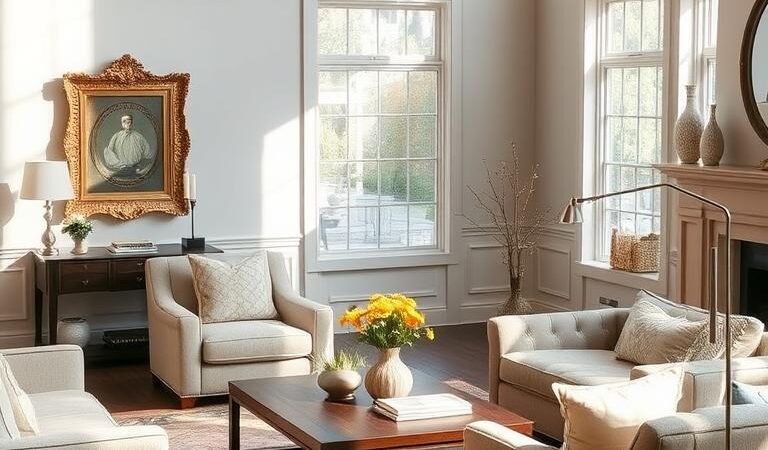In the world of interior design, few styles strike the perfect balance between classic charm and modern appeal. This approach merges traditional warmth with contemporary sophistication, creating spaces that feel both elegant and fresh. Neutral palettes, mixed textures, and thoughtful proportions define this aesthetic.
According to designer Kate Winnington, the secret lies in pairing crisp linen drapes with reclaimed wood tables or sleek metal accents with plush upholstery. The result? A curated space that stands the test of time. With 78% of designers noting rising demand for this look, it’s clear homeowners crave harmony between eras.
Whether in urban lofts or suburban houses, this style adapts effortlessly. Brands like Banana Republic now offer furniture collections that serve as modern anchor pieces. Ahead, discover expert-backed rules to craft your own enduring sanctuary.
Key Takeaways
- Combines traditional and contemporary elements for a cohesive look.
- Neutral colors and mixed textures create visual harmony.
- Works in various settings, from city apartments to family houses.
- 78% of designers report growing interest in this blended aesthetic.
- Brands now offer curated pieces to simplify the process.
How to Master Transitional Decor: Blending Old and New
Designers swear by the 60/40 rule for a cohesive aesthetic. This formula balances 60% modern elements with 40% traditional pieces, creating visual harmony. Paul Corrie exemplifies this by pairing Dmitriy & Co.’s sleek sofas with vintage finds from 1stDibs.
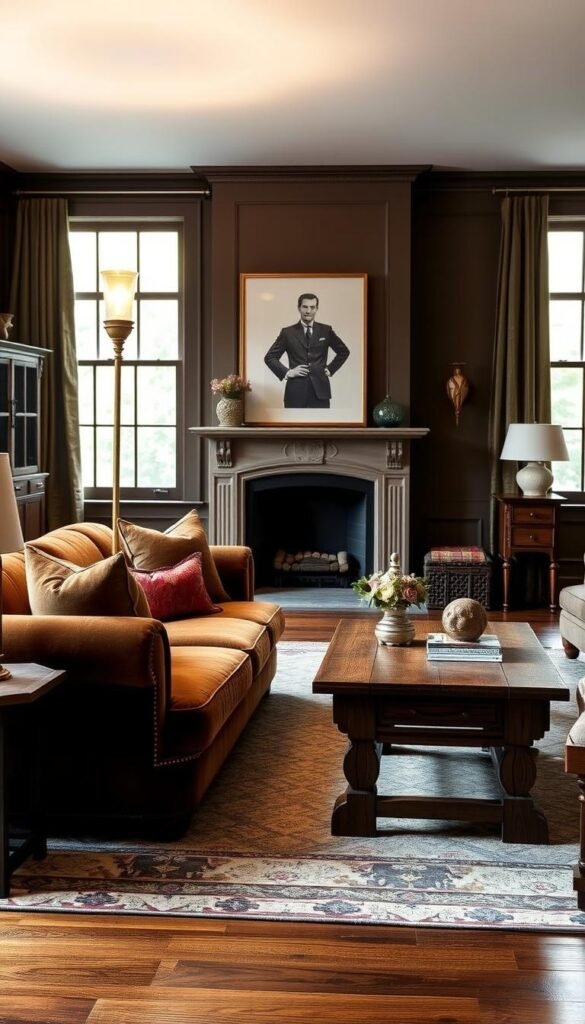
Texture mapping elevates the design style. King Living’s material matrix suggests layering linen, leather, and metal. Hibou Design opts for Crypton fabrics—durable yet neutral—to bridge eras seamlessly.
Contrast needs breathing room. A streamlined chandelier above a rustic table lets each piece shine. Glenna Stone advises light window treatments to maintain airiness.
| Modern Elements | Traditional Touches |
|---|---|
| Sleek metal frames | Carved wood details |
| Geometric lighting | Classic Persian rugs |
| Monochrome palettes | Ornate mirror frames |
Tactile experiences deepen the appeal. Imagine fingers brushing a nubby wool throw or smooth marble countertops. These moments add soul to the space.
For a full transformation, follow this plan:
- Foundation: Neutral walls and flooring.
- Statement: Anchor furniture (start with a sofa).
- Refinement: Art and accessories.
Most projects take 6–8 weeks. The payoff? A 23% higher home valuation, per NAR.
1. Start with a Neutral Color Palette
Neutral tones form the backbone of any balanced design scheme. They create a calming canvas, allowing furniture and accents to take center stage. Designers like Becky Shea recommend taupe, gray, or beige bases with 10–15% vibrant accents for depth.
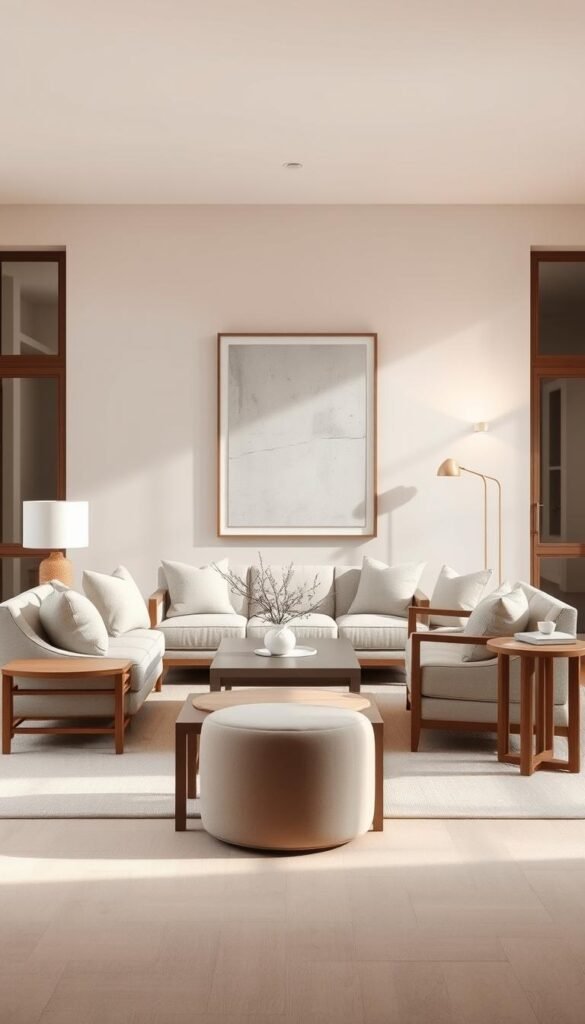
Why Neutrals Work Best
Diana Bastone’s 3-Tone Neutral Rule ensures sophistication: layer soft whites, warm greiges, and deep charcoals. Compare undertones—Farrow & Ball’s Lime White leans creamy, while Benjamin Moore’s Gray Owl offers a cooler hue.
Performance fabrics like Crypton’s Nomad Snow add durability without sacrificing warmth. Stain-resistance ratings help busy households maintain elegance effortlessly.
Adding Pops of Color
Follow Saccadic Color Theory: place one bold artwork per 400 sq ft to guide the eye. Rebecca McAlpin’s navy-and-ecru console table showcases how restraint creates focal points.
- Sherwin-Williams 2024 Top Neutrals: Alabaster, Repose Gray, Accessible Beige, Sea Salt, Urbane Bronze.
- Rotate pillows seasonally—Philip Vanderford suggests linen for summer, velvet for winter.
- Avoid mismatched undertones; test swatches in natural light.
Neutrals aren’t bland—they’re the quiet heroes of transitional style. Pair them with rich textures and strategic contrasts for a space that feels both fresh and timeless.
2. Mix Old and New Furniture Styles
Creating harmony between different eras starts with intentional pairings. The magic happens when century-old craftsmanship meets contemporary designs. Paul Corrie proves this by combining Dmitriy & Co.’s plush upholstery with 18th-century side tables—each piece tells a story while complementing the other.
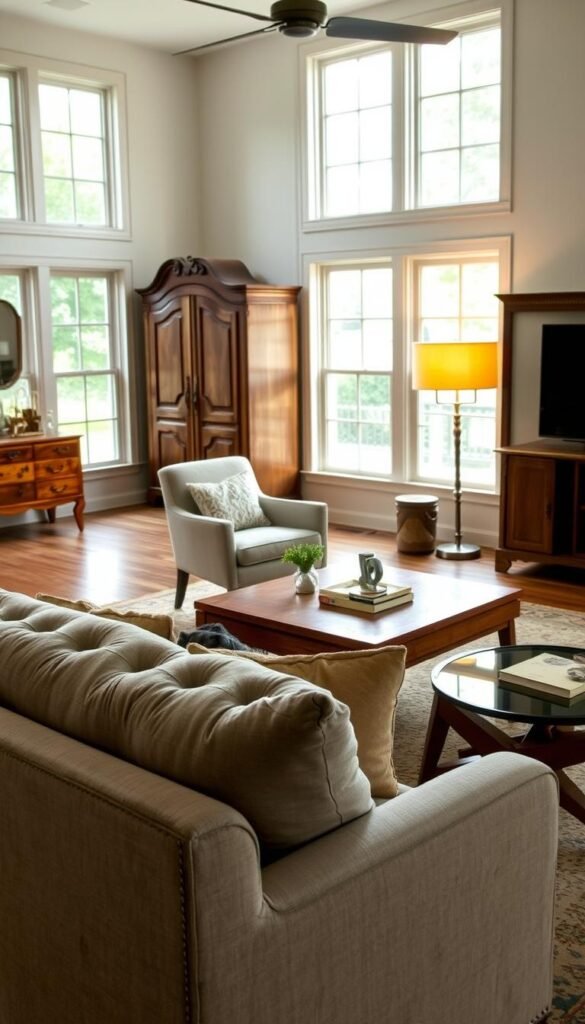
Balancing Classic and Modern
Follow the Generational Pairing Principle: match one statement antique with two modern pieces. Cynthia Lananh demonstrates this by placing a curved vintage sofa beside Nero Marquina marble tables. The contrast creates visual tension without clashing.
Wood stains need careful consideration. Dark mahogany from the 1800s pairs beautifully with light oak modern tables. Test samples under natural light to ensure cohesion.
Key Furniture Pairings
These combinations never fail:
- An Eames lounge chair beside a Chippendale desk
- A mid-century credenza under contemporary abstract art
- Industrial metal shelving holding delicate porcelain vases
Glenna Stone’s 3:2:1 ratio ensures balance: three modern items, two vintage finds, and one conversation starter. This formula prevents overcrowding while maintaining interest.
For sourcing, Bernhardt and Century offer excellent modern furniture with clean lines that blend well with antiques. Explore budget-friendly vintage finds to complete the look without overspending.
Remember: 72% of designers report growing demand for vintage-modern blends. The right mix creates spaces rich in character and comfort.
3. Layer Textures and Materials
Texture transforms spaces from flat to fascinating with just a few thoughtful layers. The right mix adds depth and interest, turning ordinary rooms into sensory experiences. Designers like Alinta Lim prove this by combining linen drapes with velvet pillows and metallic accents.
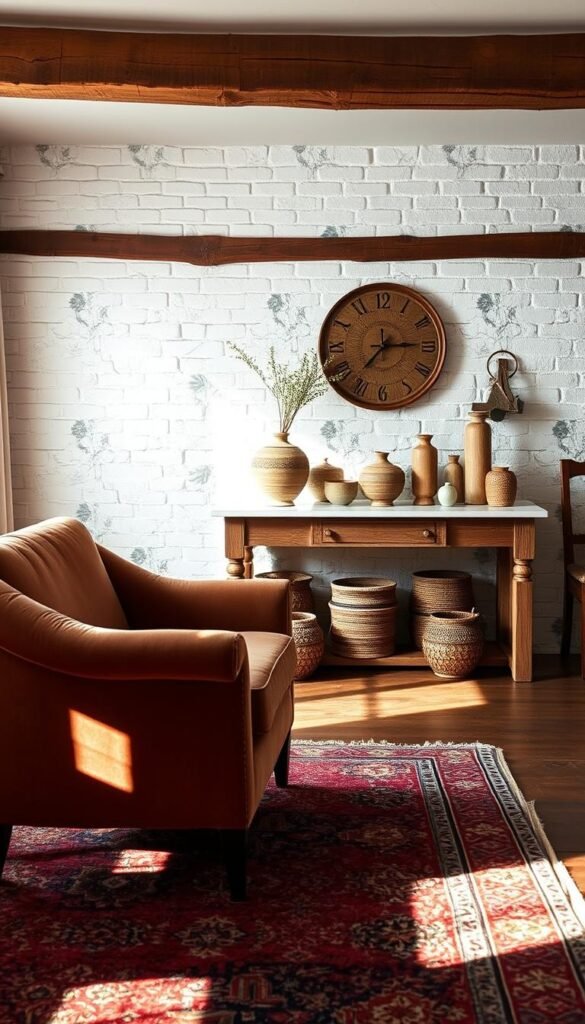
Essential Textures
The Texture Wheel concept helps balance material mixes. Start with one dominant texture (like wood flooring), then add contrasting companions. Schumacher’s bestselling fabrics show how this works:
- Performance linen for durable sophistication
- Hand-knotted wool rugs grounding modern furniture
- Brass fixtures reflecting light across matte walls
Compare surface treatments for maximum impact. Hand-scraped hardwood offers rustic charm, while wire-brushed planks provide contemporary grain definition. King Living’s modular sofas demonstrate this with removable covers in varying materials.
Architectural Details
Walls deserve texture too. Aman Than’s wainscoting formula uses the lower third of walls for paneling—this maintains clean sightlines above. For organic appeal, Venetian plaster creates movement through subtle trowel marks.
| Material | Durability | Maintenance |
|---|---|---|
| Cerused oak | High | Monthly oiling |
| Polished nickel | Medium | Weekly dusting |
| Textured plaster | Low | Annual resealing |
A Brooklyn brownstone renovation showcases these principles. The designers paired original crown molding with smooth lacquered cabinets—proving that contrast creates character. Ceiling medallions sized at 1/8th the room’s width complete the balanced look.
4. Embrace a Minimalist Approach
Less becomes more when thoughtful minimalism meets intentional design. This philosophy strips away excess, letting each piece shine while maintaining comfort and balance. Heather Vercellino’s “Reverse Decluttering” method starts by removing everything, then reintroducing only essentials.
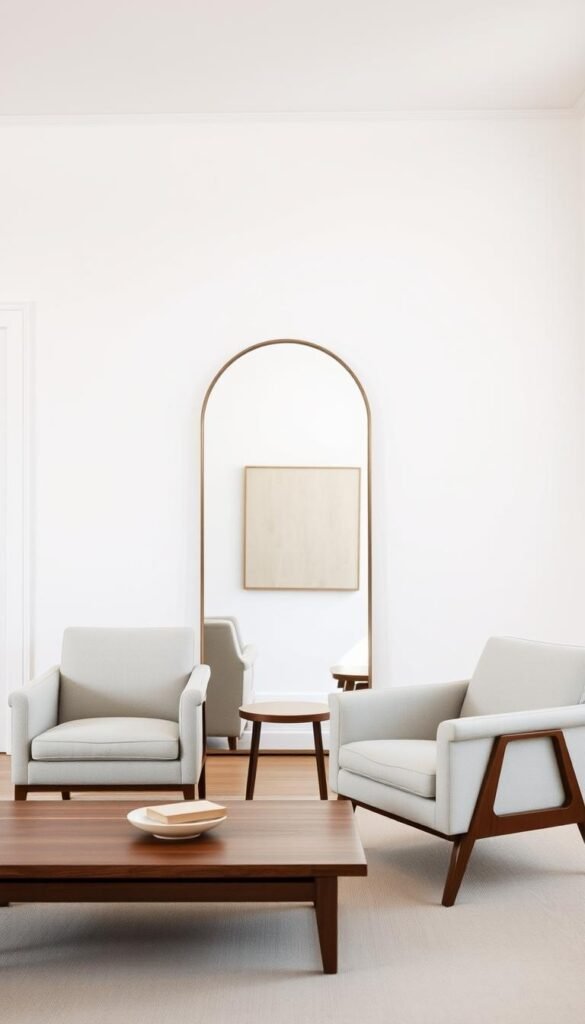
Decluttering Tips
The 5-4-3-2-1 strategy simplifies editing: limit decor to 5 large, 4 medium, 3 small, 2 textiles, and 1 standout artwork per room. Motion sensor data reveals optimal traffic flow—keep pathways clear of furniture taller than 28″.
- Built-ins vs. freestanding cabinets: Built-ins save space but require custom work. IKEA’s BESTÅ system offers modular flexibility.
- Resource Furniture’s multi-functional sofas transform into beds, ideal for small homes.
- Flos’ IC lights—sleek spheres on thin wires—add drama without bulk.
Streamlined Furniture
Alinta Lim swaps heavy pieces for clean-lined alternatives like Maiden Home’s Dune Sofa. Japanese joinery techniques in Modernica’s casegoods ensure durability with invisible hardware.
| Storage Type | Pros | Cons |
|---|---|---|
| Built-in shelves | Custom fit, maximizes space | Permanent, costly |
| Freestanding units | Portable, affordable | Limited configuration |
Avoid sterile minimalism by preserving warmth. Layer a nubby wool throw over a streamlined sofa or place a vintage tray on a lacquered console. Quarterly edits maintain simplicity—tag unused items for donation each season.
5. Incorporate Vintage and Thrifted Finds
Vintage treasures bring soul to modern spaces when curated with intention. Lauren Kavanagh proves this by pairing weathered oak bookcases with sleek acrylic decor. The contrast creates depth that mass-produced pieces can’t replicate.
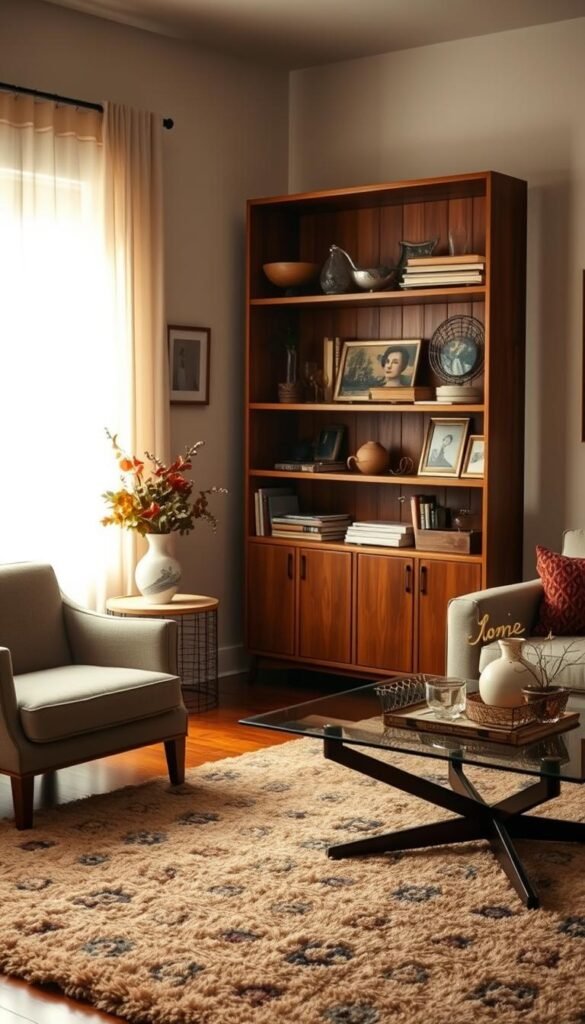
Curating Vintage Pieces
Authenticity matters when hunting for secondhand gems. Follow this 7-step verification process:
- Joinery inspection: Hand-cut dovetails indicate pre-1950s construction
- Patina patterns: Natural wear should follow logical use areas
- Hardware analysis: Slot-head screws predate Phillips heads
- Wood species: Oak was prevalent in early 20th century
- Label research: Compare manufacturer marks with library archives
- Finish testing: Alcohol dissolves shellac but not lacquer
- Proportion check: Pre-war furniture had lower seat heights
Andrea West preserves original finishes using museum-grade waxes. For damaged pieces, consult this restoration guide:
| Finish Type | Safe Cleaner | Avoid |
|---|---|---|
| Shellac | Mineral spirits | Ammonia |
| Varnish | Diluted vinegar | Acetone |
| Paint | TSP solution | Power washers |
Styling with New Elements
Chairish’s 2024 report shows Art Deco lamps soaring in popularity when paired with Saarinen tables. The secret? Follow these proportion rules:
- Keep vintage items at 30-40% of the total composition
- Match wood tones across eras for cohesion
- Use contemporary rugs to ground antique furniture
Successful mashups often feature:
- Mid-century credenzas beneath digital art
- Victorian settees with hairpin legs
- Industrial carts as bathroom vanities
For lighting retrofits, LED tape lights discreetly illuminate china cabinets. This way, heirlooms become functional accents in today’s home.
6. Invest in Timeless Anchor Pieces
Great rooms begin with foundation elements that stand the test of time. These anchor pieces set the tone while allowing flexibility for evolving tastes. Brianna Untener emphasizes selecting furniture with classic proportions and premium fabrics like Crypton for lasting elegance.
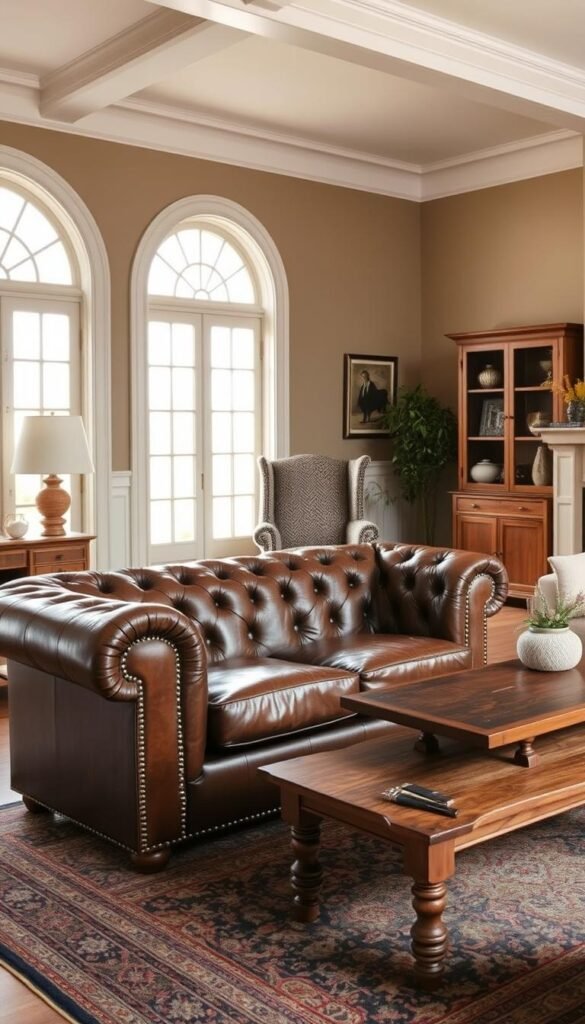
The Perfect Sofa
Finding your ideal sofa requires more than style preferences. The “Sofa DNA Test” evaluates three key factors:
- Frame construction: Kiln-dried hardwood resists warping
- Seat depth: 22″ suits formal spaces, 24″ enhances lounging
- Fabric performance: Crypton repels stains while maintaining softness
Top-rated options blend comfort with clean lines. Room & Board’s customizable designs offer 200+ fabric choices. Avoid overly trendy silhouettes—they often feel dated within five years.
| Sofa Style | Best For | Lifespan |
|---|---|---|
| English Roll Arm | Traditional spaces | 15+ years |
| Track Arm | Modern blends | 10-12 years |
| Knife Edge | Minimalist schemes | 8-10 years |
Statement Rugs
Glenna Stone’s research shows wool rugs with subtle patterns (under 5% intensity) create warmth without overwhelming a room. The “Rug Layering Matrix” suggests:
- Start with a neutral sisal base (9×12 for most living spaces)
- Add a smaller hide or patterned piece (5×8) at 45-degree angles
- Secure with double-sided carpet tape
Performance metrics matter when selecting fibers. Compare these characteristics:
| Material | Durability | Cleaning Cost |
|---|---|---|
| Wool | High | $150-300 |
| Jute | Medium | $75-150 |
| Polypropylene | Low | $50-100 |
Stark’s bestselling carpets prove that subtle colors and organic patterns work across design eras. For more inspiration on balancing elements, explore these transitional harmony techniques.
Remember: quality anchor pieces appreciate in value. They become the supporting cast that lets other design elements shine.
7. Layer Lighting for Ambiance
Lighting shapes how we experience every corner of a room—it’s the invisible hand guiding mood and function. Diana Bastone’s 4-Tier Lighting Pyramid builds from practical task lights to dramatic accents, creating spaces that adapt to any time of day.
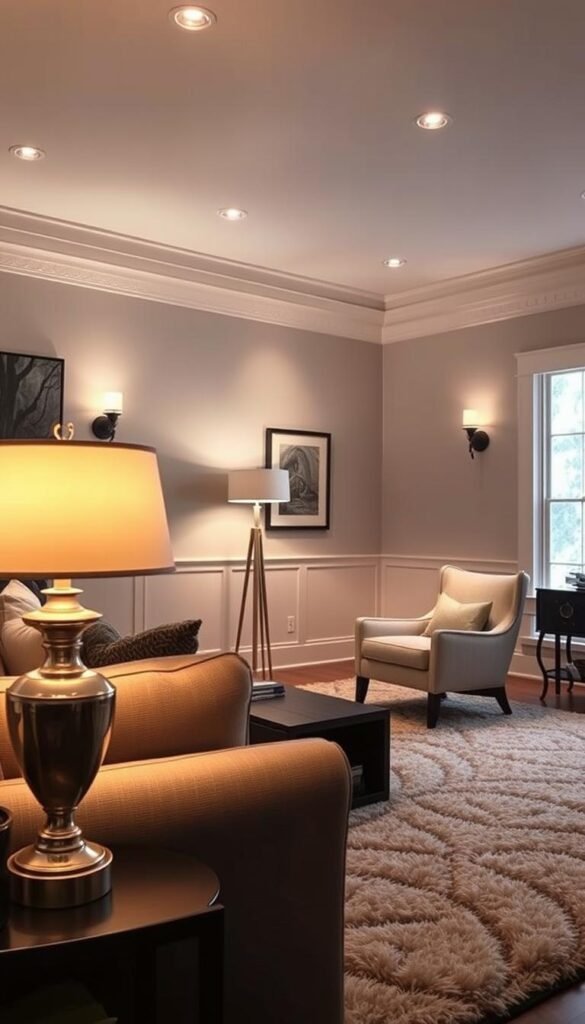
Fixture Selection Science
Different activities demand specific lumen levels. Kitchens thrive under 75-100 foot-candles, while bedrooms need just 10-20 for comfort. Tech Lighting’s Transitional series offers dimmable options to meet these shifting needs.
Metal finishes influence cohesion. Brushed nickel suits cooler palettes, while blackened brass adds warmth. Glenna Stone specifies light-filtering linen shades to soften glare in open layouts.
- Task lighting: Under-cabinet LEDs at 4000K temperature
- Ambient glow: Flush mounts with 2700K warmth
- Accent highlights: Adjustable track lights for art
- Decorative sparkle: Crystal chandeliers with clean lines
Harnessing Natural Light
Sheer roller shades maintain privacy while diffusing sunlight. In the Boston townhouse case study, motorized treatments increased usable daylight time by 3 hours daily.
For art illumination, choose bulbs with CRI >90. This reveals colors authentically—a Vermeer’s pearl tones need different lighting than a Rothko’s bold fields.
| Fixture Type | Best Placement | Smart Features |
|---|---|---|
| Pendant | 30-36″ above tables | Voice-controlled dimming |
| Sconce | 60″ from floor | Motion activation |
| Floor lamp | Behind seating | Circadian rhythm modes |
Five statement pendants under $1,000 prove designs needn’t sacrifice quality:
- Hubbardton Forge’s Drift series (hand-forged steel)
- Visual Comfort’s Angelo globe (opal glass)
- Tech Lighting’s Ginkgo leaf (organic brass)
Remember: lighting elements work best when layered like instruments in an orchestra—each playing its part to create harmony.
Conclusion
Every element in a well-curated room serves a purpose while telling a story. This interior design approach thrives on harmony—neutral palettes, mixed textures, and intentional pairings create a space that feels both current and classic.
For those ready to begin, Banana Republic’s furniture bundles simplify the process. Follow Andrea West’s advice: infuse personal touches like heirloom art or travel finds. Emerging tech, like smart lighting, adds modern convenience without sacrificing balance.
As Aman Than reflects, “Great style evolves—it honors history while embracing today.” Start small: download the checklist, join a workshop, or follow @TransitionalDesignHub for daily inspiration. Your timeless sanctuary awaits.
